On Monday this week, it was great to be school with Michelle and Francis to install the new turf floor and put up the tent frame construction. We cleared space in the assembly hall area, pulled up the blinds and let in the light! Using pale green plastic sheeting over the windows diffused the light, and made a tranquil oasis of calm. Amazing how, as staff passed through the space, they commented on the light, and how big the room suddenly seemed. Comparisons to us going camping indoors were of course taken with great humour! Made a sign saying ''Please Play on the Grass'' , to ensure full advantage would be taken by all children and staff to feel and experience the new turf rather than feel they werent allowed.
On Wednesday, myself and Francis brought in many different real leaves and created many different shaped material leaves with the children, using tactile textures, rough, soft, smooth. Working with Blue Gum class for the first session Dawn loved the smell of the Verbena leaves, the music and the feel of the fabric vines, Francis had constructed to fix leaves too. We should use more herbs and good smelling leaves in future, very effective with stimulating the sense of smell.I worked one to one with Joel, who was transfixed looking through my mobile phone view finder at the leaves and his ALD display. It was great to communicate with him through this method, and Icould see the amazing possibilities of todays technology to provide communication applications in a mobilephone for children like Joel to communicate. He also really liked to touch all the different textures of materials. Robbie came in late to the session but then very enthusiastically made his leaves.
In Banksia's class,it took time for Alex to engage but then he chose lots of shiny materials to stick on his leaf, Samuel wasnt really in the mood for tactile sensory work but he stuck his choices of textures on a leaf. It was interesting how they worked on easels, and we had to make some adjustments so they could press down on the material and glue.They all really enjoyed it, when Donkey puppet came and tried to eat their leaves!
We used the animal chorus music in the session but in retrospect it would of been great to have an atmospheric forest soundtrack.
We also linked the leaves and vines to the real Jub Jub Tree bulbs growing in pots, needing the sun & rain to make the forest grow.
I had to leave unexpectedly early , so I cant wait to see how the forest now looks!
Feedback from staff included
'Really good activity'
'Great range of textures and materials'
This is your new blog post. Click here and start typing, or drag in elements from the top bar.
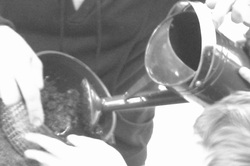 Yesterday, the artists worked all together to deliver a special gift to each class. Playing music, and singing the songs from the show, we arrived at each classroom, with the puppet characters, re introducing them with their own unique songs and rhythms, Rebecca has now recorded these in a high quality production studio so a cd of them can potentially be included in the school kit! very exciting. The music and the singing really carries the story and the activity. A combination of a flexible structure and a bit of improv, helped us to engage Room 2's class, who I think are getting to know and enjoy the characters now. The older Belmay kids certainly remember elements of the Jub Jub Tree story, and really engaged in the planting.Remebering with repetition and rhythm, the children are feeling more secure I hope in who we are and the process we are going on. Looking forward to Drama role play next Monday with the great Goat costumes made.....have also been chatting to Amber who very much wishes she was with us and misses everyone at Carson St.
Another exciting day, getting hands on again with the amazing ALD Jub Jub tree book specially made by Anne, for every class to have a copy and read whenever they like. Myself and Rebecca spent the day telling the story with music and the puppet characters to Room 2, Banksia and Room 5. It was a great experience to be able to tell the story using the visual aid of the book , and its a good practical introduction to the story again. Playing to very small groups of children is most effective and we are able to adjust in the moment to individual childs responses.During the course of the day, we edited down the story to what worked with the immediate storytelling and also developing the songs, and sound effects. Its necessary to have a clear, bold, concise voice when communicating , with lots of direct focus, the children were amazing in their responses.
Here the video of our first storytelling session with class 2 meeting the characters.....
What a full on fantastic day! Barely time to grab a bite to eat, we had most of the schools pupils and the staff of all ages! We were very privleged to have the early learning group and their parents come to visit, exploring all the areas including hot, hard, soft, slimy or wet. The wet area was a big favourite aswell as the soft space. Parents of the pre schoolers really enjoyed the experiential play, and there were very discussions of furthering the positive modelling experience at home. There was little chance to reflect as we went however, it did seem that a basic methodology could flow with the artist modelling to child and adult, then the adult modelling with the child, and the child could then respond, or it could be completely child led, depending on the individual's needs and challenges.It was a fantastic opportunity to meet everyone on a sensory level, with some fabulous education assistants, visitors and teachers joining in. The smiles on everyones faces said it all! Cant wait to see everyones photos.....
Feedback taken immediately that day from children and staff includes-
'Excellent'
'Outstanding!'
'It was so cool'
'Its like Christmas...'
'Should of been timetabled, I needed to know what I was doing when, but the activities were fabulous'
'The kids enjoyed it, especially the water'
The different textures, ADL for ech station was good'
'Bit chaotic'
'It was really good, children really participated'
1. Once upon a time there was a forest .....
(make a astro turf piece with textured leaves and vines from it.)
2. Introduce characters...
Rooster - feathers and beak
Goat - Long fur and horns
Donkey - short fur and tail
3.Hungry and cold winter?
4.They planted....
Large seed
5.They watered.....
Mini watering can & irredescent strips or real water
6.After working the animals got tired in the heat.....
Wrap up in a fleecy blanket/ heat pads.
7.That night a big storm came and it rained...
Rainstick percussion instrument
8.The tree began to grow....
Pop up puppet mini Jub Jub Tree to pass around
This is as far as we got, any ideas on simplifying sensory objects and props to engage with the experiential storytelling, that can practically fit in a kit would be greatly appreciated.
9. The next day the animals wanted to eat the fruit but the fruit was not ready.
10. Donkey crept out in the night to eat some fruit off the tree.
11. The next day Rooster and Goat wanted to know who had eaten the fruit.
12. They asked Donkey if he had eaten the fruit. When donkey said no, they didn’t believe him.
13. That night they followed Donkey and caught him stealing the fruit.
14. The animals had to wait another 7 days and 7 nights before the fruit was ready.
15. Donkey said sorry and there was a big celebration.
Much planning today with Francis, regarding how the pre school resource kit , and sensory book bag kit will work. Have discussed and decided at the artists meetings how we can break down the activities planned and laid out on the artist mind map. Having got more resources in, and ideas strengthening as we get to know the school and how we can make this theatre work more for these children. The programme plan has evolved into using the sensory walk as a n opportunity to get to know everyone, children and adults within the school, sharing a common experience. Then the 2D storybooks being presented to each class with the puppet characters, in a storytelling session, then the week after each class having their own special Jub Jub Tree bulb in a decorated pot, presented with live music and reinforcing the symbolic gift we as artists asre bringing and the experience we are all creating together.
The elements of the pre school resource kit seem to be coming together very strongly, with ideas of costume elements for each character for children to roleplay with eg. feather boa for rooster, donkey ears etc. Also simple tactile wooden/cloth puppets which symbolise each character, for hands on experience, sight impaired children. Even a mini pop up Jub Jub Tree! Therefore there is a progression from the images in the book through costume/small puppets to lifesize show for the children. there is also the potential within the kits for puppet play, role play and sensory storytelling pre show visit and post.
The afternoon was spent trying to work out the Sensory Book Bag version of the story, while we stripped the story down to the essentials, and have had time exploring the Book bag stories which already exsist in the library. It seems deceptively simple, but is actually difficult sometimes to find the correct sensory object or material for abstract , emotional or elemental concepts.How for example is 'cold winter' realised? plastic icicles and an ice pack?? Really ointeresting dilemmas of symbolic presentation and meaning.
Had a lovely time observing storytelling with Sarah and Class 2. The teacher reads The Three Little Pigs and shows the book closely to the children, asking them to reveal the hidden pictures behind the flaps. Then the goodbye song to finish the day.
Busy day moving all the materials and resources into our new space and setting up a new workshop area, buy new storage boxes and install everything with Francis in school.
Had a great meeting about the visual aid resources we need to build up for the project with Anne and Mim I.T Library support. Francis retold the story using the puppets, introducing the characters and talking about how the children are going to assist in building the forest environment, and participate in a sensory world with songs and music.
It was a great opportunity for me to refresh myself with more detail regarding the Jub Jub Tree story, and for Anne and Mim to get to know the essential elements of the story to put into a 2D aided language storybook for each class.
Fromlast weeks discussions, Anne is also giving us great support in agreeing to create a visual display in the school reception area from the previous visit of the Jub Jub Tree performance, organising aided language symbols for PODD books and assisting in the development of a 3D Sensory awareness Bag Book Style version of the story.
Myself and Francis also are drawing all these visual layers and elements into designing a pre show school resource kit, to be used with a visit by the company on future touring of the Jub Jub Tree to PMLD schools.
Had much informed discussion with Natalie, explaining the origins and theory of Conductive Education, and with Yvette, speech therapist and how to use the aided language symbols for PODD. I have alwyas been interested in how visual theatre elements and visual languages methods, can coincide and work in theatre play, so this is the perfect opportunity to look at Makaton signing etc and how theatre can be made primarily for PMLD kids.
Spent the afternoon, observing the children in Banksia class practicisng Pointililsm painting, starting to further understand how much effort goes into the most simplest of tasks and how rewarding the vital relationship between child and ea/teacher. They are amazing to watch, how they facilitate the communication and aid the childs journey.
Seeing the PODD books in action , using the symbols for the children to make choices, ask questions and communicate feelings and emotions,realising how that at first disturbing noise made , dissolves when you realise it is from the sheer effort to communicate,or make a movement.
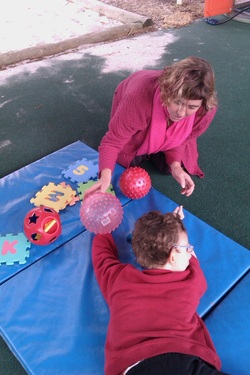 Michelle at playtime with Nikki Bluegum class Starting with a period of research and development , is giving the artists team a fantastic opportunity to get to know staff and children. The uses of Rhythmic Intention in developing processes and routines for the children is fascinating, as is the whole knowledge and practice of Conductive Education. The techniques of rhyme and action, often taken for granted as part of childrens early learning and understanding, is vital here, with body language and facial communication. It feels like a very steep learning curve for us as artists to begin to use these visual language techniques in sensory awareness performance to make this kind of theatre really work for PMLD children.
Thanks to all the staff, the doors of our perception of visual communication open wider, answering our continous questions, (so much verbal communication!)while we try to blend in the background and not cause a distraction to normal activities.
Playtime after morning tea in Bluegum, we make contact with the children using puppets and play props to communicate , introduce ourselves via their current Dinosaur theme.
Im very passionate about puppetry being a useful tool for covering visual layers, they can surprise, wait patiently for response and stimulate deeper play. It was great to be able to relax and have fun together, I can see how hard the staff and children work to do everyday things many of us take for granted.There is much to learn....
 Tahlia communicates with Rachel
|

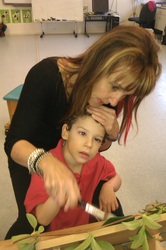
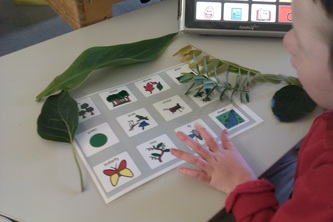
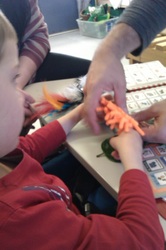
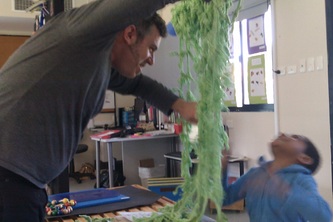
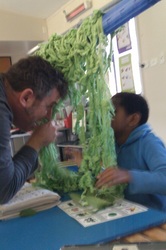
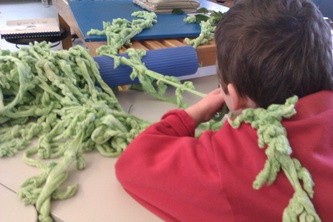
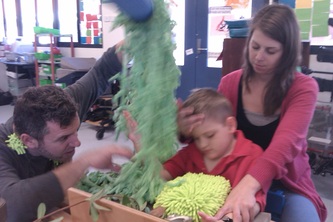


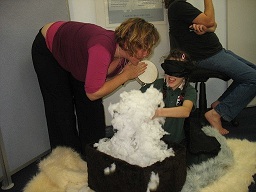


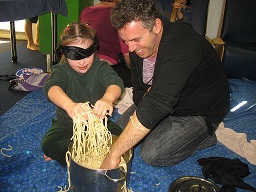
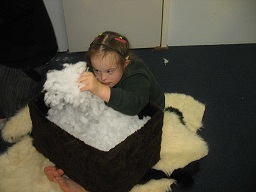

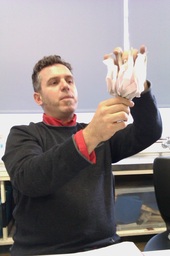
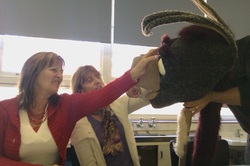
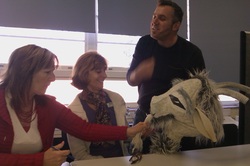
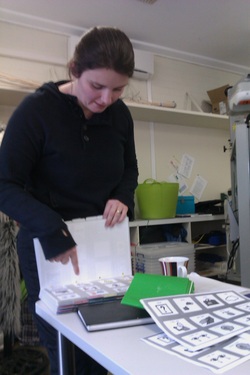


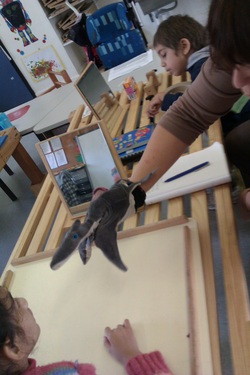
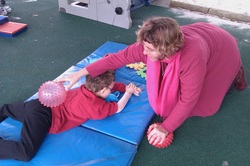


 RSS Feed
RSS Feed